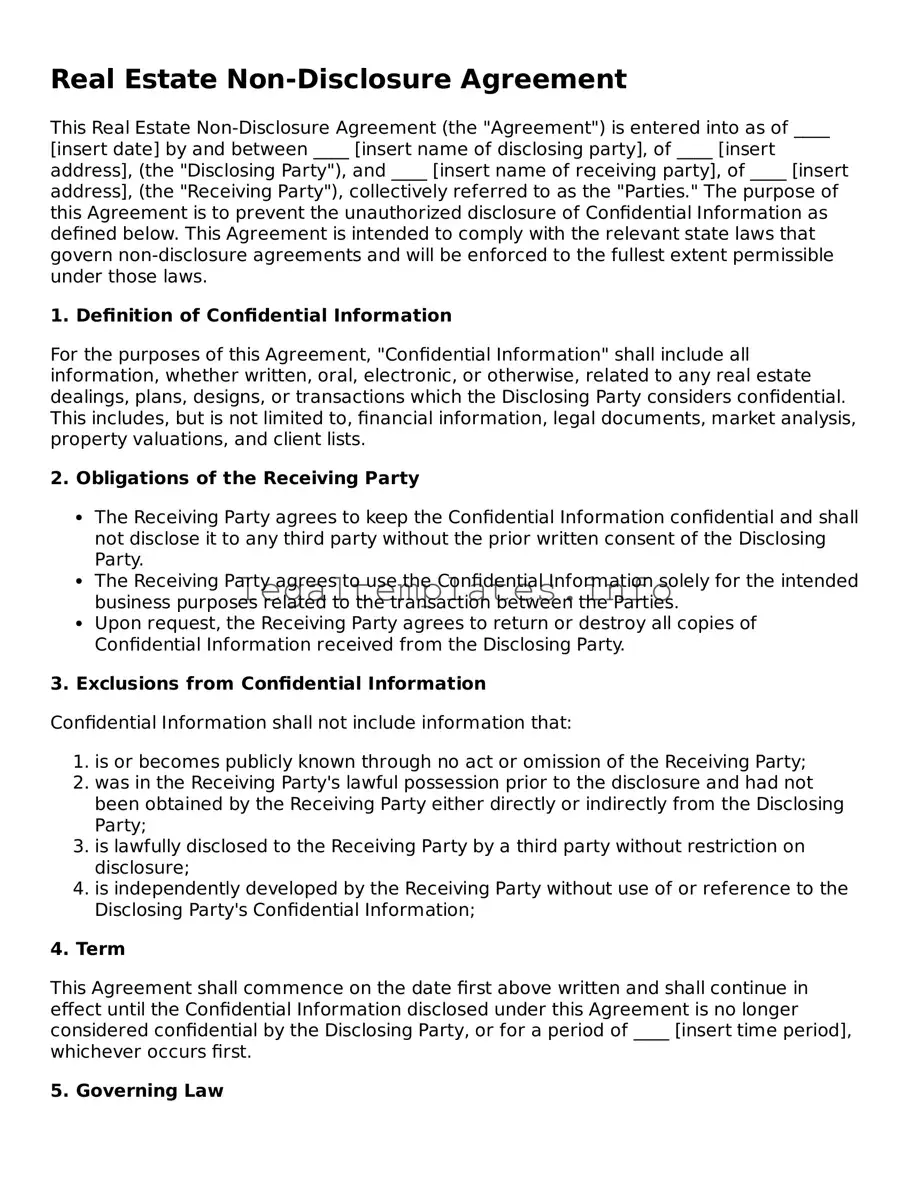Real Estate Non-Disclosure Agreement
This Real Estate Non-Disclosure Agreement (the "Agreement") is entered into as of ____ [insert date] by and between ____ [insert name of disclosing party], of ____ [insert address], (the "Disclosing Party"), and ____ [insert name of receiving party], of ____ [insert address], (the "Receiving Party"), collectively referred to as the "Parties." The purpose of this Agreement is to prevent the unauthorized disclosure of Confidential Information as defined below. This Agreement is intended to comply with the relevant state laws that govern non-disclosure agreements and will be enforced to the fullest extent permissible under those laws.
1. Definition of Confidential Information
For the purposes of this Agreement, "Confidential Information" shall include all information, whether written, oral, electronic, or otherwise, related to any real estate dealings, plans, designs, or transactions which the Disclosing Party considers confidential. This includes, but is not limited to, financial information, legal documents, market analysis, property valuations, and client lists.
2. Obligations of the Receiving Party
- The Receiving Party agrees to keep the Confidential Information confidential and shall not disclose it to any third party without the prior written consent of the Disclosing Party.
- The Receiving Party agrees to use the Confidential Information solely for the intended business purposes related to the transaction between the Parties.
- Upon request, the Receiving Party agrees to return or destroy all copies of Confidential Information received from the Disclosing Party.
3. Exclusions from Confidential Information
Confidential Information shall not include information that:
- is or becomes publicly known through no act or omission of the Receiving Party;
- was in the Receiving Party's lawful possession prior to the disclosure and had not been obtained by the Receiving Party either directly or indirectly from the Disclosing Party;
- is lawfully disclosed to the Receiving Party by a third party without restriction on disclosure;
- is independently developed by the Receiving Party without use of or reference to the Disclosing Party's Confidential Information;
4. Term
This Agreement shall commence on the date first above written and shall continue in effect until the Confidential Information disclosed under this Agreement is no longer considered confidential by the Disclosing Party, or for a period of ____ [insert time period], whichever occurs first.
5. Governing Law
This Agreement shall be governed by and construed in accordance with the laws of the State of ____ [insert the relevant state], without regard to its conflict of laws provisions.
6. Entire Agreement
This Agreement constitutes the entire agreement between the Parties with respect to the subject matter hereof and supersedes all prior or contemporaneous agreements or understandings, whether written or oral.
7. Amendment
Any amendment to this Agreement must be in writing and signed by both Parties.
8. Signature
IN WITNESS WHEREOF, the Parties have executed this Real Estate Non-Disclosure Agreement as of the date first above written.
_______________________ _______________________
Signature of Disclosing Party Signature of Receiving Party
_______________________ _______________________
Printed Name of Disclosing Party Printed Name of Receiving Party
